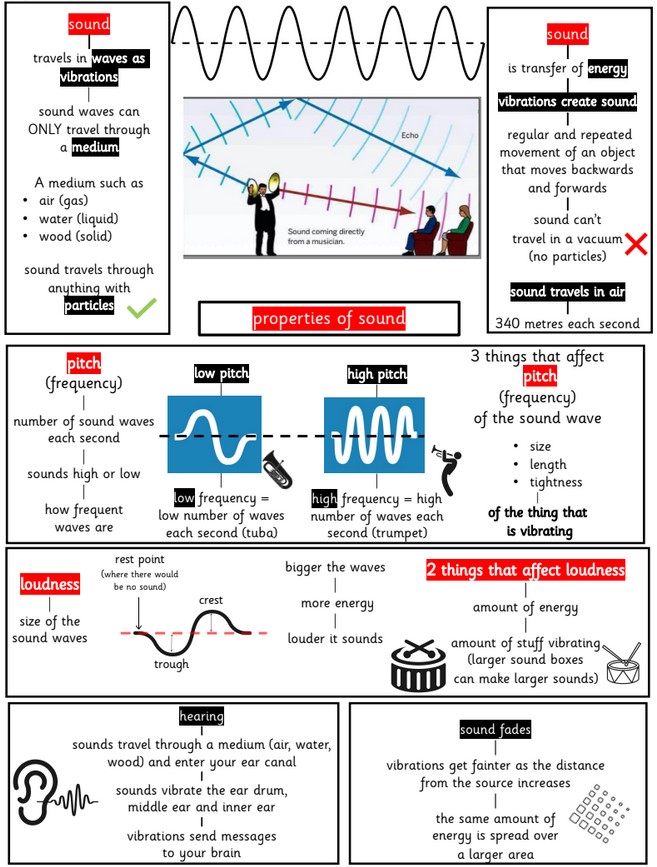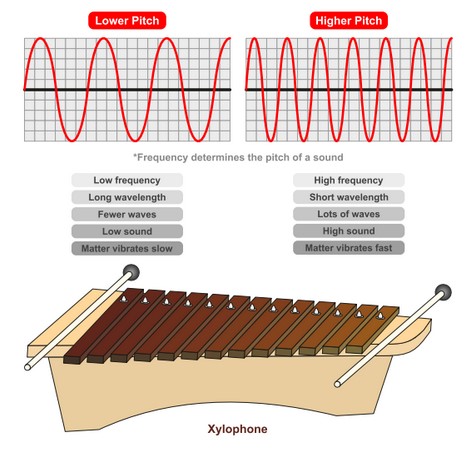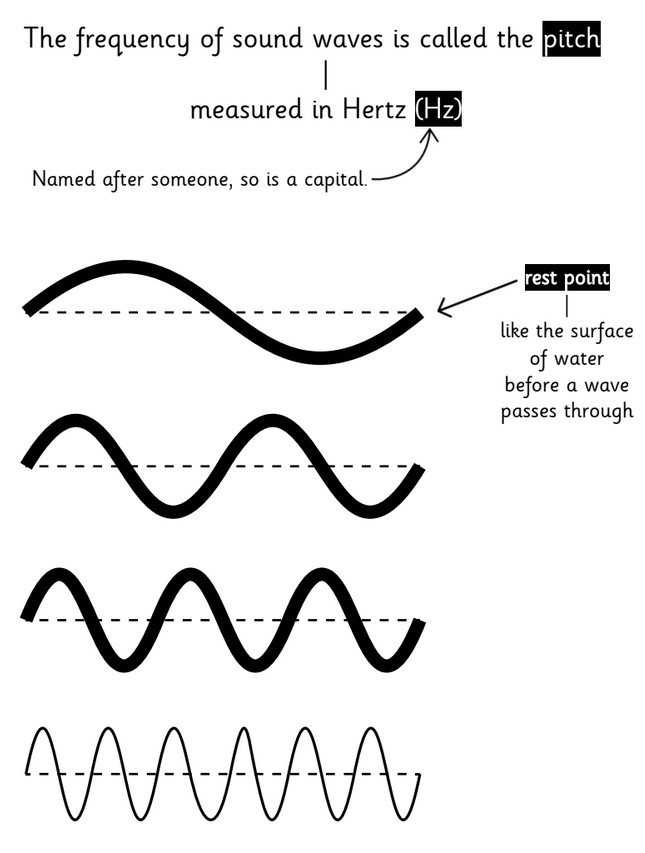Sound—what do we need to know?
What is sound?
- Sound is a thing that can be heard.
- The object that makes the sound is called a source.
How is a sound made?
- When objects vibrate, a sound is made.
- The vibration makes the air around the object vibrate and the air vibrations enter your ear. These are called sound waves.
- If an object is making a sound, a part of it is vibrating, even if you cannot see the vibrations.
How do we hear sounds?
- Sound waves travel to the ear and make the ear drum vibrate.
- Messages are sent to the brain which recognises the vibrations as sound.

How do sounds travel?
- Sound waves travel through a medium (such as air, water, glass, stone, and brick).
How do we measure sound?
Amplitude measures how strong a sound wave is.
Decibels measure how loud a sound is.
Frequency measures the number of times per second that the sound wave cycles.
How do sounds change?
Pitch:
- High pitch sounds are created by short sound waves.
- Low pitched sounds are created by long sound waves.

Volume:
- The closer you are to the source of the sound, the louder the sound will be.
- The further away you are from the source of the sound, the quieter the sound will be.

VIBRATIONS
Sound is made when an object vibrates and therefore causes the air around it to vibrate too. These vibrations are carried to your ear for you to hear them.
Sound vibrations can travel through different materials:
SOLIDS: metals, stone, wood
LIQUIDS: water
GASES: air
Sound travels better through some materials than others. It travels very well through metal pipes for example.

The louder the volume, the bigger the vibrations. The size of the vibration is called the amplitude. Quieter volumes have smaller amplitudes and louder sounds have larger amplitudes.

Sounds travel in a wave. The vibrations make air particles closest to the object vibrate, which then passes the vibrations to the particle next to it and so on – like dominoes falling!

Focus Scientist
Alexander Graham Bell was a Scottish scientist who invented the telephone in 1876.

Beth O’Leary is a live sound technician and engineer who talks about sound engineering as a career and some of the issues that come from working in a male- dominated profession (see https://soundgirls.org/contributors/beth-oleary/).
Key Vocabulary
amplitude: a measure of strength of a sound wave.
decibel: a measure of how loud a sound is.
ear: the organ of hearing and balance. It has an outer part, a middle part and an inner part.
frequency: a measure of how many times per second a sound wave cycles.
insulation: material that stops the travel of energy (including sound).
medium: something that makes it possible to transfer energy from one location to another.
pitch: how high or low a sound is.
sound: a type of energy made by vibrations.
sound waves: invisible waves that travel through the air, water and solid objects as vibrations.
source: where something comes from.
transmit: to pass from one place or person to another.
vibration: invisible waves that move quickly.
volume: how loud or quiet a sound is.
Sound


All sounds are caused by vibrators

Pitch
how high or low sounds are

The longer bars of the xylophone have a lower pitch than the shorter bars
Sound waves with increasing pitch
(also called frequency)

Sound travels as vibrations

We can see vibrations when a tuning fork is struck
and placed in the middle of a bowl of water.
Sound waves travel as vibrations down the tightened string

Sound travels most quickly through
solids and liquids.
It travels more slowly through air.
Sound waves cause other objects to resonate
(vibrate in time with the original source)

Sound waves cause other objects to resonate
(vibrate in time with the original source)


The loudness of sound is measured in decibels


Anatomy of the ear

Sound waves cannot travel through space or a vacuum

Light can travel though space or a vacuum
Light travels at about 300,000,000 metres each second (m/s)
(300,000 kilometres = 186,000 miles)
Sound travels in air at 340 metres each second
(much less than 1 kilometre)
Making Sounds
Sound is caused by vibrations from a source such as a voice.
(Vibrate means move from side to side)
These make the air vibrate.
Which makes your ear drum vibrate and you can hear it!
Sound needs a material to travel through.
This is because there needs to be a material to vibrate.
Some materials are better at letting vibrations through than others.
Sound travels fastest through solid materials like metal and wood.
It travels quite fast through liquids like water.
It still travels through gases like the air.
Sound does not travel at all when there is no air, like in space. This is called a vacuum and would be completely silent.
